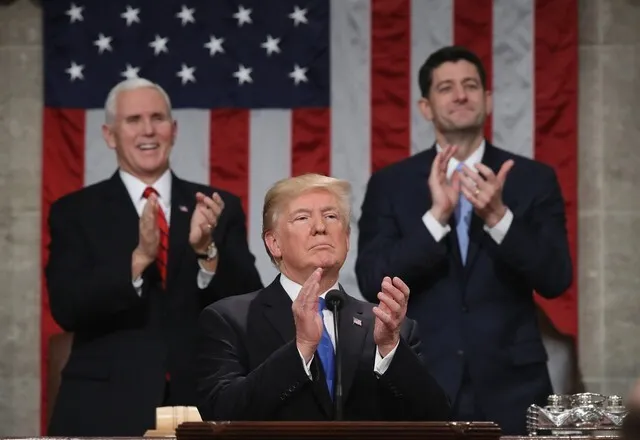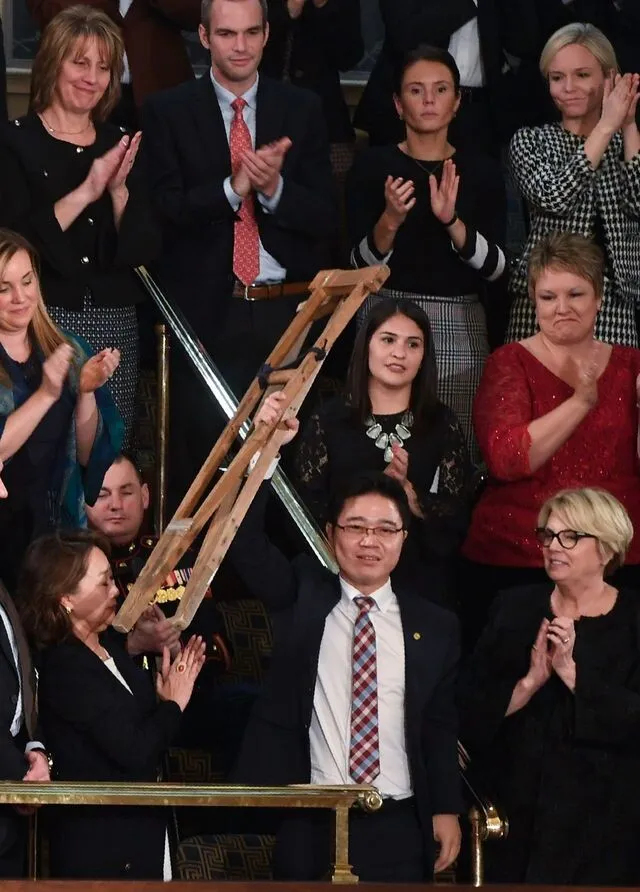hankyoreh
Links to other country sites 다른 나라 사이트 링크
Trump plans to maintain pressure on North Korean regime in bid to force denuclearization

“No regime has oppressed its own citizens more totally or brutally than the cruel dictatorship in North Korea. North Korea’s reckless pursuit of nuclear missiles could very soon threaten our homeland,” US President Donald Trump said on Jan. 30.
“We are waging a campaign of maximum pressure to prevent that from happening,” Trump said during his first State of the Union address, delivered in the US House of Representatives, which marks the beginning of his second year in office. These remarks appear to show that Trump is focused on a diplomatic solution such as sanctions, rather than military action, even while emphasizing the urgency of North Korea’s nuclear threat.
“Past experience has taught us that complacency and concessions only invite aggression and provocation. I will not repeat the mistakes of past administrations that got us into this dangerous position,” Trump went on to say. This appears to emphasize his determination to resolve the North Korean nuclear issue while also confirming his current plan to keep pressuring the North until it comes to the table for talks about denuclearization.

Trump devoted a considerable amount of his address to the issue of North Korea, but his focus was not so much on its nuclear program as on its human rights record. “We need only look at the depraved character of the North Korean regime to understand the nature of the nuclear threat it could pose to America and our allies,” Trump said before talking about Otto Warmbier, an American college student who died after being released from detention in North Korea, and Ji Seong-ho, a North Korean defector.
Trump described Warmbier’s parents, who were present at the address, as being “powerful witnesses to a menace that threatens our world.” He also said that “Seong-ho’s story is a testament to the yearning of every human soul to live in freedom.”
Trump did not mention North Korean leader Kim Jong-un by name. The language he used was less provocative than his address to the UN General Assembly in Sept. 2017, when he mocked Kim as “Little Rocket Man” and threatened to “totally destroy” North Korea, as well as his address to South Korea’s National Assembly in Nov. 2017, when he provided extensive examples of North Korea’s human rights abuses.
“This was similar to what he said in South Korea, but the location was different. If this is all he said in the US, where freedom and human rights are a big deal, it’s fair to say that he moderated his tone,” said Kim Hyeon-uk, a professor at the Korea National Diplomatic Academy.
Some analysts think that Trump’s adoption of an emotional approach – personally bringing Warmbier’s parents and Ji Seong-ho into the address – may have been more appealing to the American public than his addresses to the UN or the National Assembly.
Furthermore, Trump did not make any intimidating remarks about North Korea, as he did during his speech to the National Assembly, when he said, “Do not underestimate us. And do not try us.” This suggests that Trump is trying to avoid raising tensions in the run-up to the Pyeongchang Winter Olympics.
But Trump did not leave open the possibility of negotiating with North Korea, and his use of a dualistic narrative of good and evil suggests that his attitude toward the North has not changed. “He didn’t exacerbate the crisis about war. I think that President Trump will make a pragmatic decision when push comes to shove, but this speech appeared to reflect his view that North Korea can’t be persuaded through negotiations,” said Kim Jun-hyeong, a professor at Handong Global University.
By Yi Yong-in, Washington correspondent and Kim Ji-eun, staff reporter
Please direct questions or comments to [english@hani.co.kr]

Editorial・opinion
![[Correspondent’s column] Coupang’s game in Washington follows familiar pattern [Correspondent’s column] Coupang’s game in Washington follows familiar pattern](https://flexible.img.hani.co.kr/flexible/normal/500/300/imgdb/original/2025/1226/8217667391873536.jpg) [Correspondent’s column] Coupang’s game in Washington follows familiar pattern
[Correspondent’s column] Coupang’s game in Washington follows familiar pattern![[Editorial] Coupang’s attempt to hide behind US won’t win back Korean consumers [Editorial] Coupang’s attempt to hide behind US won’t win back Korean consumers](https://flexible.img.hani.co.kr/flexible/normal/500/300/imgdb/original/2025/1226/1817667387971465.jpg) [Editorial] Coupang’s attempt to hide behind US won’t win back Korean consumers
[Editorial] Coupang’s attempt to hide behind US won’t win back Korean consumers- Coupang under fire for possible obstruction of investigation into its customer data leak
- [Editorial] Coupang founder’s contempt for workers, customer security knows no bounds
- [Column] Confessions of a Coupang-holic
- [Editorial] Kim Bom-suk’s arrogance on full display in boycott of Coupang leak hearing
- [Editorial] The facts of Yoon’s insurrection are clear — justice cannot be further delayed
- [Column] Trump destroys government
- [Column] A post-Western world approaches
- [Column] Offshore balancing, or carving out spheres of influence?
Most viewed articles
- 1Korea to trial next-gen train capable of sub-2-hour Seoul-Busan trip starting 2030
- 2Kim Jong-un’s hidden motive in criticizing South Korea’s nuclear submarine push
- 3[Editorial] Coupang’s attempt to hide behind US won’t win back Korean consumers
- 4Coupang under fire for possible obstruction of investigation into its customer data leak
- 5[Correspondent’s column] Coupang’s game in Washington follows familiar pattern
- 6Real-life heroes of “A Taxi Driver” pass away without having reunited
- 7Moon Jae-in renews call for end-of-war declaration, peace treaty on Korean Peninsula
- 8Chang Chun-ha’s family hopes to know truth of his death after 37 years
- 9Chinese money flooding into South Korean companies
- 10Russian architect personally witnessed Empress Myeongseong’s assassination by Japanese ronin, accoun